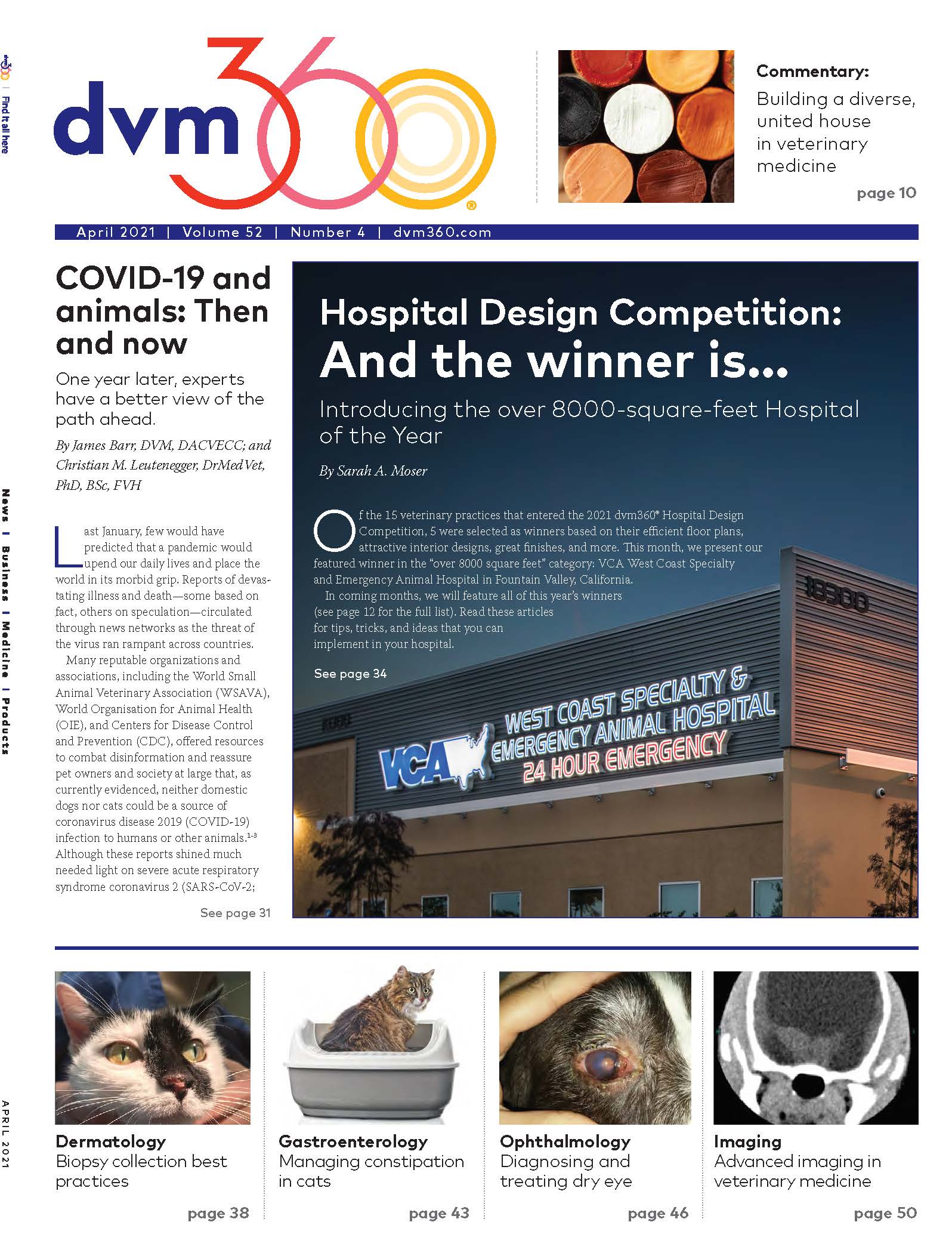Building a more diverse profession
Although strides have been made to promote equity, inclusivity, and diversity in veterinary medicine, there’s still a long way to go before we see long-lasting change.
michaeljung / stock.adobe.com

Some people might say that I have a chip on my shoulder. Let me explain.
I remember flying 2000 miles to interview a prospective veterinarian for an opening at a hospital located within my region. This candidate and I had spoken previously on the phone, but this was the era before Zoom, Google Duo, Facetime, or any visual communication—the next step was an in-person meeting. We had set a time and place to meet at a hotel lobby in a nearby town (this was also before the era of looking up people on Facebook or LinkedIn) and had a mutual understanding that we would meet there at 11:00 am on Wednesday.
I arrived and began to search the lobby for a male who appeared to be waiting for someone when I spotted the likely candidate. I casually walked over, smiled, and said, “Hello, I am Dr Hale are you, ‘Dr Who Needs A Job?’” Keep in mind, when I walked up to him and stood beside the table, he seemed to look right past me. It was as if I were blocking his view of people coming in. After all, he was meeting with a prospective employer. His gaze moved to me only when I extended my hand for a firm handshake. He remained seated as we shook hands and proceeded with small talk before the interview. We will return to this story later.
The road to diversity
I am a proud graduate of the Tuskegee University College of Veterinary Medicine, which was established in 1945. Fast forward 76 years later, and Tuskegee University remains the only historically black college and university (HBCU) with an acclaimed full pre-veterinary and veterinary curriculum. Additionally, Blacks are still disproportionately represented in the profession, making up between 1% to 2% of the population, according to the US Bureau of Labor Statistics and AVMA data.
Perhaps that may explain why, during my many years in clinical practice, I’ve often heard the following inflammatory comments from clients after finding out that their appointment would be with a Black veterinarian: “What color are the doctors here?” “Of course Black people are good animal doctors," “My dog is afraid of Black people," or, when upset over the cost of care, "This is why Black people shouldn’t run a business.” Seriously?
I have coached and comforted numerous young Black veterinarians who have experienced similar castigating remarks by clients. I have even had to fire clients due to bigoted words, insensitive remarks, and moronic comments.
My first job was at a Black-owned veterinary practice. Though this place felt like a safe haven, we were not immune to clients in east Tennessee who even in the 1990s, refused to respect a Black doctor. We often had White receptionists, that way, first appearances would create an illusion of sameness for our White clientele. While we have come a long way since then, the profession has miles to go in terms of diversity and inclusion at all levels.
I have colleagues, Black, and other minority veterinarians, who have worked hard and achieved advanced certification. Not just their DVM and VMD, but an MPH, MBA, ABVP, DACVIM, DACVD, DACVO, DACVS, and more. Many opt to establish their own specialty practices rather than compete for positions within these groups. There are also barriers to getting accepted into rigorous internships and programs as they are often reserved for others. Unfortunately, it is still not good enough to be good enough.
Let us not misconstrue the accomplishments and advancements made by minority veterinarians. I know Black veterinary colleagues who have elevated themselves in their own businesses, worked their way sideways, up, backward, and up again in academia, industry, and in corporate positions, yet, we are often alone in these positions as there can only be one of us. We get to senior vice president roles, senior division director roles, global vice presidents, or the coveted “C-suite” positions to yet again, be the only minority. That’s why we’re adamant about reaching out to help others who have immense talent but don’t have an advocate lighting their runway. Minorities have the will, skill, and desire to contribute at the highest capacity in this profession.
Recently, a young Black veterinarian asked me how to approach her regional medical director about becoming chief of staff. When she first joined this large veterinary group, she was told that she would be given that opportunity. It has been over 5 years, and no one has acknowledged her aspirations. My advice? Get their name and call them up. Remind them who you are, what was said, and what you have done professionally. “Elbow” your way through the noise and advocate for yourself. If management cannot clearly articulate a pathway either to a “yes” or “no” answer, I recommend looking elsewhere. Our industry has more opportunities for those roles now more than ever. Network and apply for leadership roles with other employers. More importantly, challenge the status quo.
Biases in veterinary medicine
There are ongoing preconceived biases in our profession, ranging from clients to prospective employers and supervisors. Take a look at our society as a whole, then narrow the focus to veterinary medicine. Black veterinarians are already the invisible people from sheer statistical numbers. When the same leaders appear over and over again, the old guard never changes. The day is fast approaching when minority veterinarians will be in positions of power within the profession, with little or no fanfare. It is just not happening fast enough.
Overcoming adversity
Now, back to my story. As the interview progressed with the White, male DVM candidate, I realized I did not have his attention. Normally, people make eye contact, face muscles relax into smiles—especially when talking about themselves. It was very apparent this veterinarian had the clinical and medical skills I needed for the role, but his body language told me he was very uncomfortable speaking with me. That could portend difficulty in leadership—would he allow me to be his boss? It was more than just interview nerves—this gentleman was not expecting a Black female to be his potential boss. He had a preconceived notion of what the boss should look like, and I didn’t seem to fit that image.
It became my responsibility to break down the wall that was potentially keeping him from a great opportunity. It would have been easy for me to walk away, and write him off for being obstinate and not giving me a chance. We were both veterinarians, we already had that commonality. What more could I say to kick through the force he wielded against me and his future? It wasn’t until I said, “You know, when I graduated back in…,” that he turned to face me. He was able to resonate with that. His face became relaxed and I finally felt heard. He was not only concerned about me being who I was but also my young age. I could see him doing the math and ascertained that we were of the same generation. The rest of the interview went well and I hired him. We worked successfully together with me as his boss for several years.
I find many times in similar interactions that it is incumbent upon the minority to make those who are uncomfortable feel more comfortable. Simply stated, this veterinarian was the one needing the job, but I had to help him ace the interview, despite his prejudice. I have encountered this scenario far too many times. Being magnanimous is rarely afforded to minorities, but always expected from us. It is burdensome, demeaning, and discrediting.
Creating a brighter future
Back to that chip on my shoulder. If I imagine that chip to be made of wood, then it is not a chip on my shoulder, nor the shoulders of many Black and minority veterinarians—It is the whole darn tree. As professionals, we are paving our way to becoming acknowledged, having equal opportunities, and advocating for doors 1, 2, and 3 to open up for us. We want equal and non-biased avenues to represent our community in the larger veterinary space. That chip we carry daily on our shoulders is a 5,000-year-old redwood with a street-wide trunk. It is a chip that has grown into a tree passed down through generations that we are wary of accommodating.
When you see us, really see us—see the tree. Compare it to when I helped that veterinarian to remove his albatross of bias. I would prefer not to have this tree. My Black veterinary colleagues would rather walk unburdened in this profession and know we will get the same opportunities as others without being on guard, without a chip to be knocked off, and without that tree on our shoulders. It is vital that veterinary leaders who wield the influence and power to help us remove that tree and recognize it for what it is—a yoke binding us to the ground, denying us from taking flight. Our taking flight doesn’t diminish your ascent. Our success is not your demise. Let us use these chips to build a united profession.
Pam Hale, DVM, MBA, is chief medical officer at Destination Pets. She graduated from the Tuskegee University College of Veterinary Medicine and earned her Master of Business Administration from St. George’s University. Dr Hale is also a member of the AVMA and Georgia VMA and serves on the dean’s council for Tuskegee University College of Veterinary Medicine and the American Veterinary Medical Association Professional Liability Insurance Trust. She also shares her home with 7 pups and her husband, Chuck.
